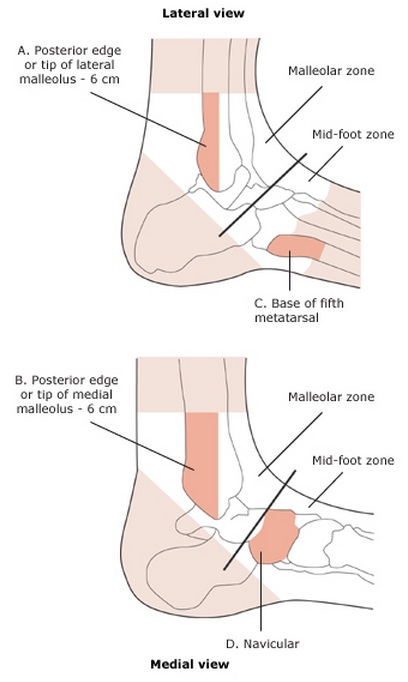Ottawa ankle rules: Difference between revisions
(added references tag) |
Neil.m.young (talk | contribs) (ref fixed) |
||
| Line 1: | Line 1: | ||
*Nearly 100% sensitive | *Nearly 100% sensitive<ref>Bachmann LM, Kolb E, Koller MT, et al. Accuracy of Ottawa ankle rules to exclude fractures of the ankle and mid-foot: systematic review. BMJ. 2003; 326(7386):417.</ref> | ||
*98.5% sensitive in the pediatric population<ref>Dowling S, Spooner CH, Liang Y, et al. Accuracy of Ottawa Ankle Rules to exclude fractures of the ankle and midfoot in children: a meta-analysis. Acad Emerg Med. 2009; 16(4):277-87.</ref> | |||
*Can reduce ED utilization of xrays<ref>Stiell, IG, et al. Implementation of the Ottawa Ankle Rules. JAMA. 1994; 271:827-832.</ref> | *Can reduce ED utilization of xrays<ref>Stiell, IG, et al. Implementation of the Ottawa Ankle Rules. JAMA. 1994; 271:827-832.</ref> | ||
==Ankle== | ==Ankle== | ||
*X-ray is only required if there is pain in the malleolar zone AND any of these findings: | *X-ray is only required if there is pain in the malleolar zone AND any of these findings: | ||
**Bony tenderness along the posterior edge or distal 6 cm of medial or lateral malleolus | **Bony tenderness along the posterior edge or distal 6 cm of medial or lateral malleolus | ||
| Line 32: | Line 33: | ||
*[[Ottawa Knee Rules]] | *[[Ottawa Knee Rules]] | ||
== | ==References== | ||
<references/> | <references/> | ||
[[Category:Ortho]] | [[Category:Ortho]] | ||
Revision as of 22:09, 3 September 2015
- Nearly 100% sensitive[1]
- 98.5% sensitive in the pediatric population[2]
- Can reduce ED utilization of xrays[3]
Ankle
- X-ray is only required if there is pain in the malleolar zone AND any of these findings:
- Bony tenderness along the posterior edge or distal 6 cm of medial or lateral malleolus
- Inability to bear weight immediately after injury AND for at least four steps at the time of ED or doctor's office evaluation
Foot
- X-ray is only required if there is pain in midfoot zone AND any of these findings:
- Bony tenderness over the navicular bone
- Bony tenderness over base of the 5th metatarsal
- Inability to bear weight immediately after injury AND for at least four steps at the time of ED or doctor's office evaluation
Exceptions
- Age <6 or >55
- Only for blunt trauma mechanism
- Does not apply to subacute/chronic injuries
- Does not apply to injuries of the hindfoot or forefoot
Imaging
External Links
See Also
References
- ↑ Bachmann LM, Kolb E, Koller MT, et al. Accuracy of Ottawa ankle rules to exclude fractures of the ankle and mid-foot: systematic review. BMJ. 2003; 326(7386):417.
- ↑ Dowling S, Spooner CH, Liang Y, et al. Accuracy of Ottawa Ankle Rules to exclude fractures of the ankle and midfoot in children: a meta-analysis. Acad Emerg Med. 2009; 16(4):277-87.
- ↑ Stiell, IG, et al. Implementation of the Ottawa Ankle Rules. JAMA. 1994; 271:827-832.



